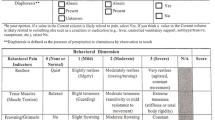Abstract
Background
Temporal patterns in aneurysmal subarachnoid hemorrhage (aSAH) may provide insight into modulation, and therefore, prevention of hemorrhage. We investigated the time of hemorrhage and its relationship to traditional risk factors among patients admitted with aSAH.
Methods
Admitted patients with aSAH were prospectively followed through outcomes and baseline demographics were abstracted through chart review. The group temporal distribution by hour of onset was summarized with cosinor nonlinear least squares. aSAH onset was gathered into night (2300–0500), morning (0500–1100), afternoon (1100–1700), and evening (0500–2300) daily phases. The odds ratio (OR) with 95% CI was calculated for having an aSAH during the morning, afternoon, and evening hours using night as a reference. Multinomial logit models were fitted using aSAH cases across time blocks to determine their associations with different risk factors.
Results
202 patients had the hour of hemorrhage available, and 49 had phase identifiable [total 251: 38 (15%) night, 98 (39%) morning, 58 (23%) afternoon, 57 (23%) evening]. The peak hours of aSAH were between 0700 and 0800 representing 13% of the sample, with a significant cosinor-fitted phase of 7.33(95% CI 5.30, 9.36). For all aSAH cases, morning onset was significantly more common than night onset (OR = 2.58, 95% CI = 1.77–3.75). Nonsmokers were more likely to have aSAH in the morning than smokers (P = 0.043, OR = 3.10, 95% CI = 1.33–7.23).
Conclusions
aSAH occur in a diurnal, morning prevalent pattern regardless of traditional aSAH risk factors. The association of these risk factors with existing onset patterns should be investigated in future studies.

Similar content being viewed by others
References
Feigin VL, Rinkel G, Lawes C, et al. Risk factors for subarachnoid hemorrhage: an updated systematic review of epidemiological studies. Stroke. 2005;36(12):2773–80.
Tsementzis SA, Gill JS, Hitchcock ER, Gill SK, Beevers DG. Diurnal variation of and activity during the onset of stroke. Neurosurgery. 1985;17:901–4.
Marler JR, Price TR, Clark GL, et al. Morning increase in onset of ischemic stroke. Stroke. 1989;20:473–6.
Kelly-Hayes M, Wolf PA, Kase CS, Brand FN, McGuirk JM, D’Agostino RB. Temporal patterns of stroke onset: The Framingham Study. Stroke. 1995;26:1343–7.
Sloan MA, Price TR, Foulkes MA, et al. Circadian rhythmicity of stroke onset: intracerebral and subarachnoid hemorrhage. Stroke. 1992;23:1420–6.
Nyquist PA, Brown RD Jr, Wiebers DO, Crowson CS, O’Fallon WM. Circadian and seasonal occurrence of subarachnoid and intracerebral hemorrhage. Neurology. 2001;56:190–3.
Turin TC, Kita Y, Rumana N, et al. Diurnal variation in onset of hemorrhagic stroke is independent of risk factor status: Takashima Stroke Registry. Neuroepidemiology. 2010;34(1):25–33.
Vermeer SE, Rinkel GJ, Algra A. Circadian fluctuations in onset of subarachnoid hemorrhage: new data on aneurismal and perimesencephalic hemorrhage and a systematic review. Stroke. 1997;28:805–8.
Ricci S, Celani MG, Vitali R, La Rosa F, Righetti E, Duca E. Diurnal and seasonal variations in the occurrence of stroke: a community-based study. Neuroepidemiology. 1992;11:59–64.
Kleinpeter G, Schatzer R, Böck F. Is blood pressure really a trigger for the circadian rhythm of subarachnoid hemorrhage? Stroke. 1995;26(10):1805–10.
Stergiou GS, Vemmos KN, Pliarchopoulou KM, Synetos AG, Roussias LG, Mountokalakis TD. Parallel morning and evening surge in stroke onset, blood pressure, and physical activity. Stroke. 2002;33:1480–6.
Anderson C, Ni Mhurchu C, Scott D, Bennett D, Jamrozik K, Hankey G, Australasian Cooperative Research on Subarachnoid Hemorrhage Study Group. Triggers of subarachnoid hemorrhage: role of physical exertion, smoking, and alcohol in the Australasian Cooperative Research on Subarachnoid Hemorrhage (ACROSS). Stroke. 2003;34(7):1771–6.
Abe T, Ohde S, Ishimatsu S, et al. Effects of meteorological factors on the onset of subarachnoid hemorrhage: a time series analysis. J Clin Neurosci. 2008;15(9):1005–10.
Beseoglu K, Hänggi D, Stummer W, Steiger HJ. Dependence of subarachnoid hemorrhage on climate conditions: a systematic meteorological analysis from the diusseldorf metropolitan area. Neurosurgery. 2008;62(5):1033–8. discussion 1038–9.
Hofman MA, Swaab DF. The human hypothalamus: comparative morphometric and photoperiodic influences. Prog Brain Res. 1992;93:133–47.
Longstreth WT, Nelson LM, Koepsell TD, Van Belle G. Subarachnoid hemorrhage and hormonal factors in women. A population-based case-control study. Annal Intern Med. 1994;121(3):168–73.
Hunt WE, Hess RM. Surgical risk as related to time of intervention in the repair of intracranial aneurysms. J Neurosurg. 1968;28:14–20.
Frontera JA, Claassen J, Schmidt JM, et al. Prediction of Symptomatic Vasospasm after Subarachnoid Hemorrhage: the Modified Fisher Scale. Neurosurgery. 2006;59(1):21–7.
Quigg M, Straume M, Menaker M, Bertram EH. Temporal distribution of partial seizures: comparison of an animal model with human partial epilepsy. Ann Neurol. 1998;43:748–55.
Saper CB, Lu J, Chou TC, Gooley J. The hypothalamic integrator for circadian rhythms. Trends Neurosci. 2005;28:152–7.
Kelly DF, Gonzalo IT, Cohan P, et al. Hypopituitarism following traumatic brain injury and aneurysmal subarachnoid hemorrhage: a preliminary report. J Neurosurg. 2000;93:743–52.
Bendel S, Koivisto T, Ruokonen E, et al. Pituitary-adrenal function in patients with acute subarachnoid hemorrhage: a prospective cohort study. Crit Care. 2008;12:1–10.
Kagerbauer SM, Rothoerl RD, Brawanski A. Pituitary dysfunction after aneurysmal subarachnoid hemorrhage. Neurol Res. 2007;29:283–8.
Acknowledgments
Everyone who made meaningful contributions is listed as author on this manuscript. Bichun Ouyang performed the multinomial logit regression analysis. Mark Quigg performed the cosinor nonlinear least squares analysis.
Author information
Authors and Affiliations
Corresponding author
Rights and permissions
About this article
Cite this article
Temes, R.E., Bleck, T., Dugar, S. et al. Circadian Variation in Ictus of Aneurysmal Subarachnoid Hemorrhage. Neurocrit Care 16, 219–223 (2012). https://doi.org/10.1007/s12028-011-9640-6
Published:
Issue Date:
DOI: https://doi.org/10.1007/s12028-011-9640-6




